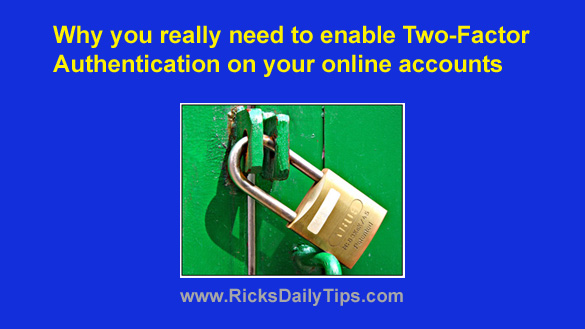
Want to get my easy to follow Tech Tips in your email?
Sign up for my daily Rick’s Tech Tips Newsletter!
The long chain of data breaches that have been in the news of late should be a huge wake-up call for everyone who is concerned with their online security.
It seems that every day or two we hear that another online service has been hacked and their customers’ personal information stolen.
Short of simply closing all of your online accounts, there’s really nothing you can do to prevent the services you use from getting hacked since the security of their servers and software is entirely out of your control.
There are a couple of things you can do however to limit a successful hacking attack’s effects on your own life:
1 – Limit the amount of personal and financial information you provide to any online service to the bare minimum required in order to use the service.
And the reason is simple: The less information you allow a company to store on their server, the less information a hacker will be able to steal if he/she breaks in to it.
2 – Enable Two-Factor Authentication on every online account that supports it.
While it isn’t perfect, Two-Factor Authentication is one of the most effective tools you can use to keep hackers and scammers from illegally logging into your online accounts, even if they somehow manage to get your passwords.
In regards to number one above, once hackers have possession of your personal and financial information they can do pretty much anything they want to do with it.
And if that happens, you’ll likely be left to try to clean up the mess they create for you all on your own.
But there’s better news in regards to number two…
Enabling Two-Factor Authentication on any online account will add another bar that a hacker must hurdle in order to gain access to that account.
What’s more, that extra bar is extremely high since it’s highly unlikely that the hacker will have physical access to your mobile phone.
After you enable Two-Factor Authentication on an account the service will send an authentication code to your mobile phone every time someone tries to log in to the account.
Anyone attempting to log into that account (yes, even you) will have to enter the code from that text message or app before he/she will be logged into the account, even if they know your password.
In a nutshell, in addition to needing something you know (your password), a hacker would also need to have physical access to something you own (your mobile phone) before being granted access to your account.
Since any potential hacker is very unlikely to have access to your phone, enabling Two-Factor Authentication is an extremely secure method of locking down your online accounts.
I strongly recommend that you enable Two-Factor Authentication on every one of your online accounts right away.
You can find instructions for enabling Two-Factor Authentication on most any online account simply by searching the web for the term enable two-factor authentication on [name of service].
For example, if you were seeking instructions for enabling it on Facebook you would search for enable two-factor authentication on facebook.
Bottom line: While you can’t control the security of a company’s servers, you can make it difficult for a hacker to use your stolen login credentials to log into your accounts simply by enabling Two-Factor Authentication on every account that supports it.
Bonus tip: This post explains how to choose a password that’s easy to remember, yet extremely hard to break.